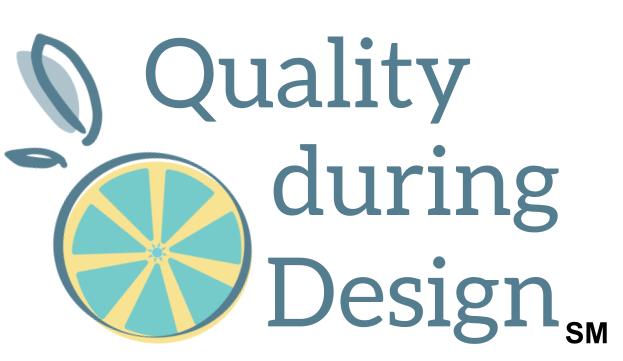The likeness of the Pareto Principle can be compared to Murphy's Law and the Peter Principle: it's a curious phenomenon. So, how did it make its way into quality? If using it to make decisions, there are some common pitfalls which can lead to delays in fixing a problem or even misdirect our efforts. So, what is it, and how can we use it for design? Coming up after this brief introduction…
Hello and welcome to Quality During Design the place to use quality thinking to create products, others love for less. My name is Dianna. I'm a senior level quality professional and engineer with over 20 years of experience in manufacturing and design. Listen-in and then join the conversation at qualityduringdesign.com.
A Pareto Chart is a pretty commonly used tool in quality and also project management, corporate finance and economics. In quality, it is one of the seven basic quality tools that Mr. Juran proposed. In Six Sigma, it is used a lot in the measure phase. And there is an ASQ magazine called Quality Progress that features, regularly, a comic strip called “Mr. Pareto Head” (which is a play on “Mr. Potato Head”, or so I read from an interview of the artist). A Pareto Chart was coined by Mr. Juran and is based on the Pareto Principle, and the Pareto Principle is a general observation. It's not mathematically sound or scientifically accurate. It's a curious thing that seems to happen repeatedly, but it's not guaranteed to happen. It is part of a list of some other fun laws like I mentioned in the introduction (like Murphy's Law and Peter's Principle). There's a fun list that I found on the internet about these laws, so I'll attach a link to it in this podcast blog.
The Pareto Principle is named after an Italian economist, Vilfredo Federico Damaso Pareto. He published (in the 1890s) a paper that showed about 80% of the land in Italy was owned by 20% of the population. Lore has it that he started seeing that ratio everywhere, even down to the pea plants in his garden. Other people notice that it seemed to carry through in other things to this 80/20 rule. So, the Pareto Principle is, generally, that 80% of the output is caused by 20% of the input. Or 80% of the consequences come from 20% of the causes, and those 20% of the causes is dubbed “The Vital Few”.
Why would we want to apply this in our engineering and design processes? Well, it's a tool to separate the “vital few” factors from the “trivial many”. Or in plain speak, we want to spend the least amount of effort we need in order to make the biggest effect. A Pareto Chart helps us to identify if we've got a cause or a short list of causes that we can work hard to solve to fix most of the problems.
Typical use cases of a Pareto chart are:
- time spent on tasks
- sales revenue from the number of customers
- problems versus defects
- number of complaints from the number of customers
- percent of funding from the number of investors
The curious thing about the Pareto Principle is that it spans lots of things. But remember, it's just a principle or a curiosity.
What is a Pareto Chart? It's a type of histogram [it's a bar chart - not a histogram!], but it ranks things. It's a combination bar chart and line chart. The bar chart shows a count: how often something happens or how often it caused creates an event. Each bar represents a count of a bin or bucket like age, range, or cause. And the bars are organized from most frequently occurring to the least. So, we can imagine it steps down, peaked at the left axis and trailing downward. Then a line graph is superimposed on top of that histogram showing the cumulative percent number of occurrences. The line arches up to 100% on the right side of the graph. In this podcast blog, at qualityduringdesign.com, I’ll provide a link to a Harvard X YouTube video. It's about how to construct one. And, I’ll also include a picture of a Pareto chart.
Something people like about the Pareto Chart is that to construct it you don't need to know a lot about statistics. However, it is not a thoughtless exercise. We need to build and interpret the data correctly in order to make the right decision. If not, it could lead to delays in fixing a problem because of a misunderstanding, or we could misdirect our efforts in trying to solve the problem.
Something that goes a long way in creating a good Pareto Chart is the design of its histogram, specifically the design of the data collection categories, or bins.
- We need to make sure that the bins and categories align with meaningful activities that can be done to address the issue. A problem that practitioners have noticed is that teams don't drill down far enough to get to the root cause.
- The bins for a Pareto Chart also need to follow the MECE Principle, which is an acronym for Mutually Exclusive and Collectively Exhaustive. What it really means is that a data point should only be able to go into one bin, and we have enough bins that they cover the entire scope of the problem.
- For example, if we're creating histogram or Pareto chart about somebody's age, we wouldn't want to label the age 0 to 20 for one bin and the next bin as 20 to 40. If one of our results was counting a 20-year-old, which bin would they go in? Those bins are not mutually exclusive.
- As far as covering the entire scope of the problem, we can think about if we're counting foods: we would want to ensure that we have a bin for each food group presented. We wouldn't want to just have categories that cover vegetables, grains, dairy. Where would the fruits go? Including all the subgroups would be collectively exhaustive.
Specific to Pareto Chart bins, there are some assumptions that need to be made:
- each category or each bin should be of equal importance
- the potential occurrence of each category should be the same
- the risks and their severities and occurrences are the same
If the Pareto chart meets these assumptions, then we can more confidently take it at face value. If not, there's some other things that we can do to make sure that we are analyzing the data properly.
When we're interpreting the results of a Pareto chart, we have to be careful of just looking at ‘frequency’.
- We need to note that our 80%/20% mix may not be specifically 80/20. We could end up with 78% of the issues or 83% of the issues being caused by 23% of the problems. And that's another thing to note: is that our mix may not add up to 100, and that's OK.
- A mistake that can happen when we're looking at a Pareto chart to make decisions is picking factors as dominant when they're not. If we get a flat histogram (in other words, there isn't a lot of variation in the counts of our categories), then we can’t conclude that any one category is dominant. We may need to re-classify the data or investigate other factors. Maybe our data didn’t follow the MECE principle.
- We need to make sure that we're asking the right question: “Are 20% of the factors contributing to 80% of the issues?” The wrong question is, “How many factors contribute to 80% of the issues?” Remember that we’re looking for the ‘vital few’ causes, so our initial work of addressing the problem gets us the furthest to our goal.
- Another mistake when looking at our Pareto Chart is trying to address the top contributor only, anyway, when the 80/20 rule doesn't apply. Practitioners notice that you may not get the results you want. You may be working with your team really hard on that top priority problem and not getting very far in fixing it.
- Another mistake that can happen when we're looking at our Pareto Chart is focusing only on ‘frequency’ and ignoring the cost or effort to resolve the problem. This kind of gets into our assumptions when we were creating our Pareto Chart. If our categories don't have equal importance and the potential occurrence of each category is not the same, then there are some things that we can do.
- To fix for categories with different levels of severities or importance: We can apply a weight. So, for example, we can multiply the results by a factor so that we get a weighted frequency, then reprioritize and redo our Pareto Chart. The weight can be qualitative, and it can be based on assumptions or someone's judgement call. This factor can also be based on cost savings when the fix is implemented.
- To fix for categories with different likelihood of occurrence: We can calculate the rate of the issue and then turn frequencies into rates of occurrence.
- We can also combine both severity and occurrence factors if we have a situation with both.
- Lastly, we can create a 3D Pareto Chart where we include other factors that are important to us on a third, Z-axis. Instead of multiplying by a factor, we get a visual of the factor across our different categories and can decide the best course of action from there.
To conclude:
- A Pareto Chart is a useful tool for planning when trying to address the root cause of a problem. It's been used for many years and can help us make a decision on the strategy of action.
- The results of a Pareto Chart might not be textbook. It is based on a phenomenon not a proven scientific law. It's more of a compass for a root cause than a statistical result.
- We need to think about and interpret its results to make a decision.
- Like building histograms, we need to be careful to construct it with the right bins: low enough in a causal chain for us to take action against, following the MECE Principle, and adjusting for categories that don't carry the same weight in severity or occurrence or even difficulty to resolve.
What can you do with what we've been talking about today? Well, get to know the Pareto Chart. If it's built and applied properly, it can help us prioritize the root cause analysis for things like complaint investigations or V&V failures. For new design features based on user input. And it can help us tackle a problem that just seems too big to even start.
Please visit this podcast blog and others at qualityduringdesign.com. Subscribe to the weekly newsletter to keep in touch. If you like this podcast or have a suggestion for an upcoming episode, let me know. You can find me at qualityduringdesign.com, on Linked-In, or you can leave me a voicemail at 484-341-0238. This has been a production of Denney Enterprises. Thanks for listening!


